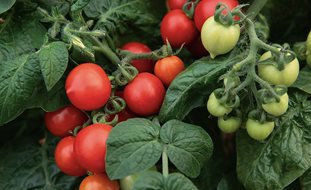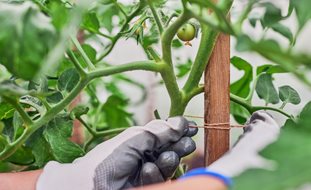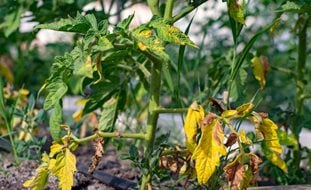How to Prune Tomato Plants
Get the most out of your tomato harvest with this growing technique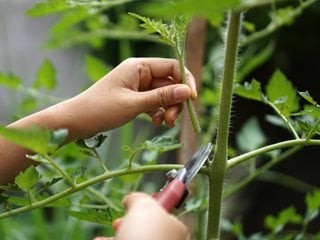
Trim off suckers by pinching or with pruning shears.
Tomatoes are one of the most popular vegetables for home gardeners to grow. There are nearly endless growing tips on what will improve your harvest and quality of fruit. If you’ve ever heard about pruning tomato plants but don’t know if, why, or how you should, you’re not alone.
When done correctly, pruning tomatoes can create stronger and healthier plants, resulting in a better yield and improved fruit quality. Pruning is not absolutely necessary, but is one way to get the most out of your fruit production.
Whether you should prune depends on the growth habit of your tomato plants, your climate, site, and growing conditions. Here are some tips to get you started on pruning your tomato plants.
KNOW YOUR TOMATO TYPES
Should all tomato plants be pruned?
Tomatoes are classified into two basic groups, indeterminate, and determinate. Most tomato varieties are indeterminate, with a vining habit. They grow continuously through the season and produce fruit over a longer period of time. Vining types can benefit from all types of pruning.
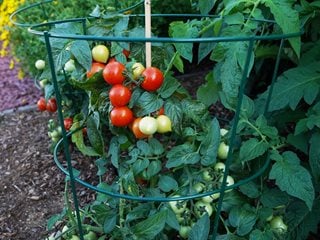
Bush tomatoes, such as this Tempting Tomatoes® Goodhearted® tomato, should be pruned minimally or not at all. Photo by: Proven Winners.
Determinate types have a bushy habit, stop growing when they reach a certain size, and produce ripe fruit all at once. Because the fruit on bush types ripens in a shorter amount of time, these are a good choice for short-season climates. The compact habit of bush tomatoes is suitable for containers and small spaces. Bush tomato plants should be minimally pruned or not at all, as they may have a poorer yield if pruned incorrectly.
WHY PRUNE TOMATOES?
There are many reasons why tomato plants may benefit from pruning:
Reduction in diseases. Tomatoes are susceptible to diseases such as blight, septoria leaf spot, and bacterial wilt, particularly in humid climates. These diseases can significantly impact tomato harvest or even kill the plants. Pruning improves airflow, which reduces air humidity inside the plant and allows foliage to dry out more quickly after it rains. Creating this drier environment helps reduce waterborne diseases.
Improved plant vigor. Pruning allows more sunlight into the center of the plant, improving photosynthesis, which results in more vigorous plant growth. Reducing shade on fruit helps it to mature and ripen more quickly.
Larger fruit. Removing some of the foliage allows plants to put more energy into producing fruit, resulting in larger fruits rather than more foliage and smaller fruits.
Reduced breakage. Plants that are left unpruned can experience broken branches or collapse from the weight of the excess foliage and mature fruit. Pruning can reduce the risk of plant injury.
More manageable plants. With pruning, plants can be kept to a more manageable size and it prevents them from sprawling. Vining tomatoes can be more easily trained onto a trellis or other support so they are easier to maintain and harvest.
Control problems. Selective pruning throughout the growing season whenever problems appear on foliage or branches can help control the spread of disease.
HOW TO PRUNE A TOMATO PLANT
There are several ways to prune tomato plants. Here’s how:
Find out what type of tomato you are growing. The first step to pruning tomatoes is figuring out whether you are growing a determinate or indeterminate tomato variety. This information can be found on identification tags, in nursery catalogs, or on seed packets. Indeterminate tomato plant varieties include most cherry tomato and heirloom tomato varieties, as well as popular slicing varieties such as ‘Big Boy’ and ‘Beef Master’. Determinate tomatoes include ‘Roma’, ‘Celebrity’, ‘Ida Gold’, and ‘Patio F’.
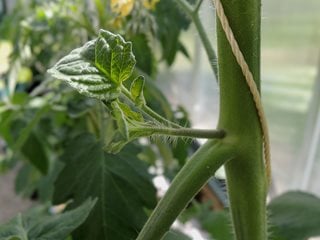
Suckers are excess growth that saps energy from the rest of the plant. Trim them out as they appear to improve harvest for indeterminate tomato varieties. Photo by: Dajra / Shutterstock.
Remove suckers. In the joint between the stem and branches, tomato plants produce suckers, which are excess growth that diverts energy away from the main stem and primary branches. Suckers will grow their own leaves, flowers, fruit, and more suckers, resulting in too much foliage and a more unwieldy plant. Removing tomato suckers will limit growth, allowing for better air circulation and improved plant health.
Indeterminate varieties will benefit from the removal of most or all suckers, while determinate types should only have suckers removed below the first flower cluster. Removing suckers above the first flower cluster on bush types will result in the loss of fruit.
Cut out suckers when they are small, 3 inches long or less. Larger suckers can be pruned, but it may result in stress or damage to plants. Cutting out all the suckers will leave a single main stem with side branches. Some gardeners will leave one or two suckers to develop into a two or three-stemmed plant.
Check plants regularly, as suckers will continue to develop during the growing season. Smaller suckers can be removed by pinching, while larger suckers can be cut out with scissors or pruning shears. Sterilize tools with rubbing alcohol in between pruning each plant to avoid spread of disease.
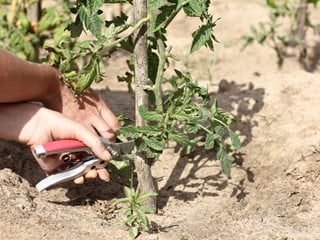
Cut out any lower branches touching the soil to help reduce the risk of disease. Photo by: Azem / Shutterstock.
Remove lower branches. Disease spores that commonly affect tomatoes live in the soil. Branches on the lower part of the plant that touch the soil can be more susceptible to viral, fungal, or bacterial infections that can spread to the rest of the plant. These branches should be removed, staked, or tied so they don’t touch the ground. This will allow better air circulation around the base of the plant, helping to minimize the spread of diseases. Both vining and bush types can benefit from this type of pruning.
Provide support. Tomato plants grown in your vegetable garden should be given support to grow upright. This can be in the form of a stake, trellis, wire, or tomato cages. Vining plants that are pruned to one or two main stems are easier to handle when tied to a support. (See more: Staking Tomatoes: A Simple How-To Guide)
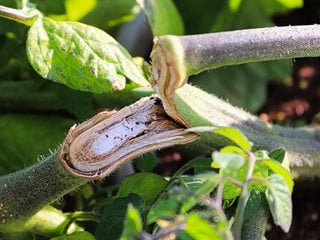
Unpruned tomato plants can become top heavy from the weight of excess foliage and fruits, resulting in branches that bend or break. Photo by: Amelia Martin / Shutterstock.
Cut out damaged foliage. Damaged foliage saps energy from the plant and is more susceptible to pests and disease. If there are any signs of leaf spots, yellow or brown leaves, damage or disease on foliage or branches, affected parts should be removed immediately and discarded in the garbage rather than compost pile to prevent the spread of disease.
Top pruning. When it gets towards the end of the growing season, the top growth tips on vining tomatoes can be cut back to stop plants from growing any further. This will put more energy into ripening the existing fruit, rather than allowing plants to produce more fruit, which may not have time to ripen.
Don’t over prune. If you remove too many leaves, fruit may be exposed to too much sun in hotter climates, resulting in scalding of the fruit skin. Removing more than one-third of the foliage can result in plant shock or the plant dying. If you’re not sure how much to prune, less is better.
FREQUENTLY ASKED QUESTIONS
When should tomatoes be pruned?
Sucker pruning of vining tomatoes can be done throughout the growing season. Start pruning suckers after the first set of flowers appears, which occurs when plants grow 12 to 18 inches tall. Prune out bottom leaves whenever you see them touching the soil. Late pruning of vine tips should be done at least 30 days before your average first frost date. Avoid pruning when foliage is wet to prevent the spread of disease. Prune in the cooler hours of morning or evening rather than the hottest part of the day to reduce plant stress.
What happens if you don't prune tomatoes?
Plants that are not pruned will direct their energy to mostly leafy growth, which can result in too much foliage at the expense of fruit, spindly stems, and undersized fruit. It can also increase the risk of foliage diseases due to poor air circulation, a delay in ripening of the fruit, or a poorer harvest.
Should I trim the lower branches on a tomato plant?
Cutting off lower branches that touch the ground can reduce the risk of soil-borne diseases.
Does pruning tomato plants increase yield?
Properly pruned tomatoes will result in fewer, but bigger fruits. Unpruned or minimally pruned tomato plants may produce more fruits, but they will be smaller.
